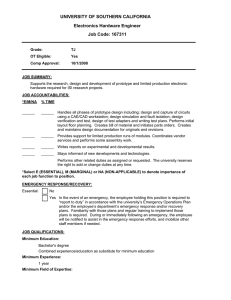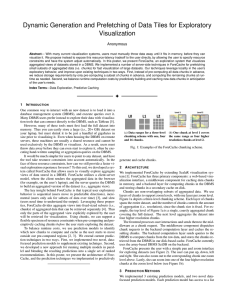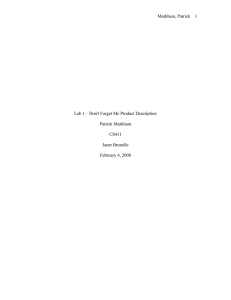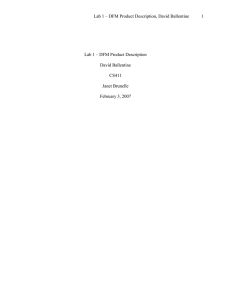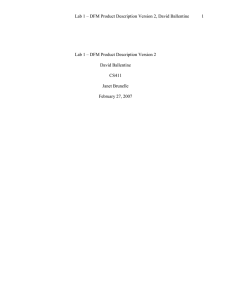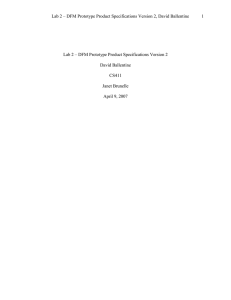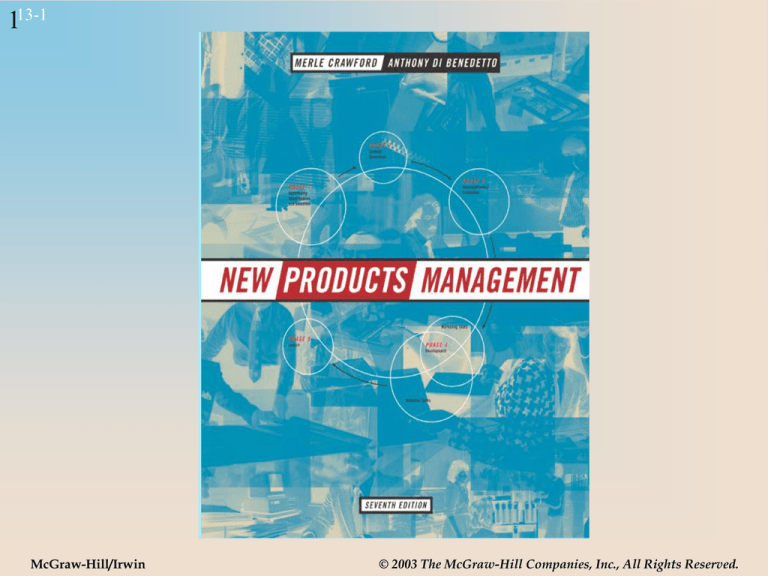
113-1
McGraw-Hill/Irwin
© 2003 The McGraw-Hill Companies, Inc., All Rights Reserved.
213-2
PART
FOUR
DEVELOPMENT
313-3
Development
Figure IV.1
413-4
CHAPTER THIRTEEN
DESIGN
513-5
What Is Design?
• Has been defined as “the synthesis of technology and
human needs into manufacturable products.”
• In practice, design can mean many things, ranging
from styling to ergonomics to setting final product
specifications.
• Design has been successfully used in a variety of
ways to help achieve new product objectives.
• One thing it is not: “prettying up” a product that is
about to manufactured!
613-6
Contributions of Design to the New
Products Process
Figure 13.1
713-7
Range of Leading Design Applications
Figure 13.2
Purpose of Design
Item Being Designed
Aesthetics
Ergonomics
Function
Manufacturability
Servicing
Disassembly
Goods
Services
Architecture
Graphic arts
Offices
Packages
813-8
Product Architecture
• The process by which a customer need is
developed into a product design.
• Solid architecture improves speed to market,
and reduces the cost of changing the product
once it is in production.
• Product components are combined into
“chunks,” functional elements are assigned to
the chunks, and the chunks are interrelated with
each other.
913-9
Product Architecture Illustration
Figure 13.3
13-10
10
Product Architecture and Product Platforms
• Product architecture development is related to
establishing a product platform.
• If chunks or modules can be replaced easily
within the product architecture, “derivative
products” can be made from the same basic
platform as technology, market tastes, or
manufacturing skills change.
• Examples: 200 versions of the Sony Walkman
from four platforms.
13-11
11
Assessment Factors for an Industrial Design
Figure 13.4
13-12
12
Prototype Development
• Comprehensive Prototype: complete, fullyfunctioning, full-size product ready to be
examined by customers.
• Focused Prototype: not fully functioning or
developed, but designed to examine a limited
number of performance attributes or features.
– Examples: a crude, working prototype of an electric
bicycle; a foam or wood bicycle to determine
customers’ reactions to the proposed shape and
form.
13-13
13
Model of the Product Design Process
Figure 13.6
13-14
14
Improving the Interfaces in
the Design Process
• Co-location
• Digital co-location
• Global teams
• Produceability engineer
• Upstream partnering with vendors
13-15
15
Computer-Aided Design (CAD)
• Greatly accelerates the design step and allows
assessment of multiple possible designs
without building expensive prototypes.
• Design for Manufacturability (DFM): search
for ways to minimize manufacturing costs.
• Design for Assembly (DFA): search for ways to
ease assembly and manufacture.
• Rational for DFM: A seemingly trivial detail in
design phase might have huge manufacturing
cost consequences later on!
13-16
16
Some of the Uses of CAD in Auto Industry
• Determining fit of subassemblies: does the
radio/CD player protrude too far into the
engine area?
• Facilitating “decking” of cars (attaching the
powertrain to the upper body): do all the pieces
fit together perfectly?
• Crashworthiness: can we modify any aspects of
the car’s design to improve its ability to protect
the passengers in a crash?
13-17
17
New Developments in CAD
• Stereolithography (rapid prototyping)
• Mechanical computer-aided engineering
(MCAE)




